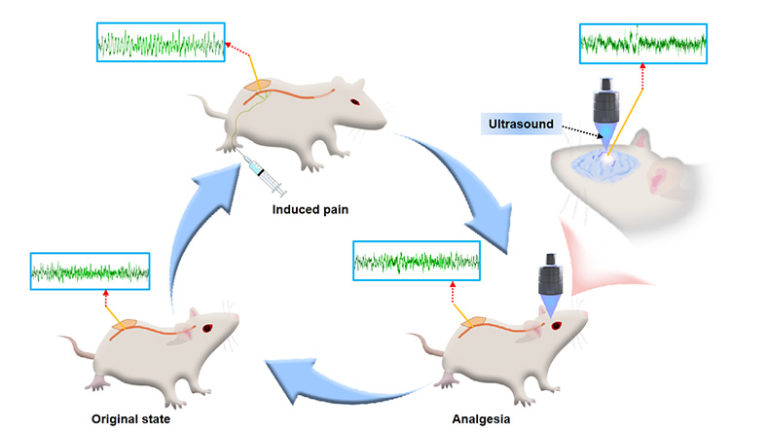Pain, as a common problem faced by human beings, seriously endangers people’s health and quality of life, and brings a huge economic burden to society consequently. Hence, analgesia remains an important field of research and attracts a growing concern. This study aims to explore the feasibility of transcranial focused ultrasound (tFUS) stimulation as a non-invasive approach for analgesia applications.
We firstly designed an analgesia scheme using tFUS stimulation technology and then examined with animal experiments. In detail, 50 μl of 3% formalin solution was injected into the rat’s left hindpaw to build a pain model, and then the local field potential (LFP) activities of the dorsal horn were tracked to reflect pain state of animals. The tFUS (US-650 kHz, PD = 1 ms, PRF = 100 Hz, 691 mW/cm2) was conducted to stimulate the periaqueductal gray (PAG) brain region for 5 minutes to suppress formalin-induced pain. In addition, the analgesia mechanism (LFP recording from the PAG) and safety assessment (histology analysis) were carried out.
The analysis of the LFP power spectra of delta (0-3 Hz), theta (4-7 Hz), alpha (8-12 Hz), beta (13-30 Hz), and gamma (31-100 Hz) waves indicated the LFP intensity increased after formalin injection. Moreover, significant decreases of LFP power were reached during tFUS mainly located in delta, theta, beta, and gamma wave (P < 0.05), suggesting tFUS stimulation of the PAG suppress effectively the nociceptive activity generated by formalin. Additionally, the tFUS stimulation was able to activate the PAG directly without causing notable temperature change and tissue injury. All the results illustrated that the tFUS stimulation of the PAG can achieve the effect of analgesia, which provides new insights into the development of non-invasive analgesic technology in the future

